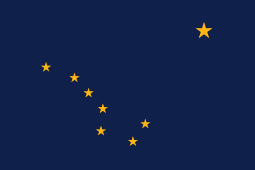Flag of Alaska facts for kids
 |
|
| Use | Civil and state flag |
|---|---|
| Proportion | 5:7.08 |
| Adopted | May 2, 1927 |
| Design | Eight gold stars, in the shape of "the big dipper", on a blue background. The North Star is larger than the other 7. |
| Designed by | Benny Benson |
The state flag of Alaska displays eight gold stars, forming the Big Dipper and Polaris, on a dark blue field. The Big Dipper is an asterism in the constellation Ursa Major which symbolizes a bear, an animal indigenous to Alaska. As depicted on the flag, its stars can be used as a guide by the novice to locate Polaris and determine true north, which varies considerably from magnetic north.
The design was created by Benny Benson of Seward and selected from among roughly 700 entries in a 1927 contest. In 2001, a survey conducted by the North American Vexillological Association placed Alaska's flag fifth best in design quality out of the 72 Canadian provincial, U.S. state, and U.S. territory flags ranked. It finished behind the flags of New Mexico, Texas, Quebec, and Maryland respectively.
Contents
Design and origin
More than 30 years before Alaska was to become a state, the Alaska Department of the American Legion sponsored a territorial contest for Alaskan children in grades seven through twelve. Winning the contest in 1927, the design of Benny Benson, a 13-year-old Alaska Native residing at the Jesse Lee Home for Children in Seward, was chosen to represent the future flag of the Territory of Alaska. Up to that time, Alaskans had flown only the U.S. flag since the territory was purchased from Russia in 1867. Benson's design was chosen over roughly 700 other submissions from schoolchildren territory-wide in grades 7–12. Most other entries featured variations on the territorial seal, the midnight sun, the northern lights, polar bears, and/or gold pans. To celebrate his achievement, Benson was awarded US$1,000 and an engraved watch.
Benny looked to the sky for the symbols he included in his design. Choosing the familiar constellation he looked for every night before going to sleep at the orphanage, he submitted this description with it:
The blue field is for the Alaska sky and the forget-me-not, an Alaskan flower. The North Star is for the future state of Alaska, the most northerly in the union. The Dipper is for the Great Bear—symbolizing strength.
History
Russian-American Company flag
Between 1799 and 1867 Alaska was governed by the Russian-American Company (RAC), a state sponsored commercial company initially headquartered in Irkutsk, then St. Petersburg, Russia. The flag flown by the Company's ships and their shore establishments was Russia's commercial flag (civil ensign). On September 28 (October 10, new style) 1806, Aleksandr I, Emperor of Russia made a notation on the design submitted to him of a new flag for the Russian-American Company; "So be it", and added his cypher, thereby approving the first flag in Russia's history to be used by an Imperial chartered company. After Imperial confirmation the ukaz was heard in the Senate and on 19 October 1806 was sent for execution to the main office of the Russian-American Company (RAC), and also to the Admiralty and Commerce colleges.
The new Company flag design of 1806 placed the Imperial eagle in the upper left quarter of Russia's commercial flag. In order that the State symbol remain unobstructed and more visible the width of the white stripe was enlarged to cover roughly one half of the flag's width. The normal width proportions of Russia's commercial flag were equal thirds. The Imperial eagle carried a scroll which dipped into the blue stripe, also for more visibility, which read, in abbreviated form "Russian American Company's". The symbolism of the scroll beneath the Imperial eagle compliments the official version of the Company's name "Under His Imperial Majesty's Protection Russian-American Company."
The flag flew over Alaska until October 18, 1867, when all Russian-American Company holdings in Alaska were sold to the United States.
State flag
The Alaska Legislature adopted Benson's design as the official flag for the Territory of Alaska on May 2, 1927. The first flag made based on Benny's design was made of blue silk and appliquéd gold stars, and was inaugurally flown July 9, 1927. It was retained as the state flag upon statehood in 1959.
The flag's symbolism is described in the state song, "Alaska's Flag".
Flags flown before 1927
| Allegiance | Governing Body | Design(s) | Dates in Use |
|---|---|---|---|
| Claimed by Russian explorers | None |  |
1729 – July 8, 1799 |
| Russian Empire | Russian-American Company (Shelikhov-Golikov) |  |
July 8, 1799 – October 10, 1806 |
| Russian Empire | Russian-American Company (used as civil ensign) |  |
October 10, 1806 – October 18, 1867 |
| United States of America | The Department of Alaska (United States Army) |  |
October 18, 1867 – July 3, 1877 |
| United States of America | The Department of Alaska (United States Army) |  |
July 4, 1877 – July 3, 1884 |
| United States of America | District of Alaska |  |
July 4, 1884 – July 3, 1891 |
| United States of America | District of Alaska |  |
July 4, 1891 – July 3, 1896 |
| United States of America | District of Alaska |  |
July 4, 1896 – July 3, 1908 |
| United States of America | District of Alaska |  |
July 4, 1908 – July 3, 1912 |
| United States of America | Territorial Alaska |  |
July 4, 1912 – July 9, 1927 |
| United States of America | Territorial Alaska State of Alaska |
 |
July 9, 1927 – January 3, 1959 January 3, 1959 – Present |
Images for kids
See also
 In Spanish: Bandera de Alaska para niños
In Spanish: Bandera de Alaska para niños


